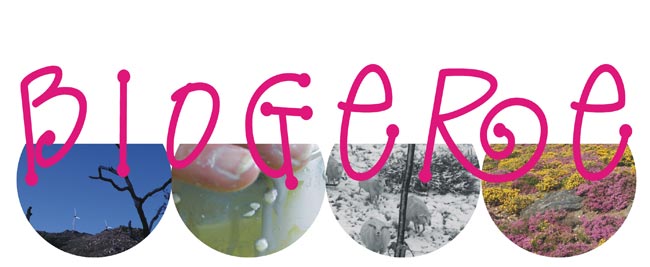http://www.weareitaly.net/en/product/Fiore-Sardo/sardegna/Fiore-Sardo-DOP.html
Sardinia is known for the production of great sheep milk cheeses, made still today following the same recipes used by the ancient shepherds who have always lived in this beautiful country. Among the most important products we can find Fiore Sardo DOP, whose origins are probably more ancient than those of other famous cheeses, as Pecorino Sardo and Pecorino Romano, both PDO.
HISTORY AND CURIOSITIES
The history of Fiore Sardo can be easily associated with the one of the same Sardinia. The first populations of the isle, in fact, have already understood the great potential of the sheep breeding for their surviving, obtaining high quality milk and cheeses.
According to the evidences, the first versions of Fiore Sardo can be dated more than one thousand years before Christ, during the Bronze Age. The original inhabitants used cardoon flowers to obtain a coagulating power, adding it to sheep milk to allow its coagulation.
The name “Fiore Sardo”, in fact, derives from the custom to use cardoon flowers, feature that has been replaced progressively by the modern rennet, despite some manufacturers still follow the original technique for the production of other local cheeses.
More recent evidences, instead, has demonstrated that anciently Fiore Sardo was left to mature inside some wooden stamps, made from pear or chestnut trees, that had a stylized flower inlayed, very similar to the peony or asphodel. It seems that each manufacturer could adopt a different flower, allowing him to distinguish his wheel from the others.
For its historical, cultural and gastronomic importance, Fiore Sardo cheese has been awarded with the Protected Designation of Origin in 1996, becoming even a Slow Food presidium for the product made in Barbagia, in the Province of Nuoro.
PRODUCTION AND REGULATION
Fiore Sardo DOP is made following the precise indications of its Regulation.
Milk is collected from Sarda race sheeps, bred in Sardinia. After the milking, the fresh milk is added with lamb rennet, rarely goat rennet, inside big copper cauldrons, called “lapiolos”, at a temperature of 33-35° C.
After 15 minutes, the buttermilk separates form the solid part, the curd, from which it will be produces cheese. For this reason, curd is broken in little pieces, using a traditional tool, called “chiova”. Lately, it is left to compact for 5 minutes and then it is extracted and put in some iron stamps with a diameter of 22 centimeters.
Each wheel is turned upside down many times, with specific traditional movements, called “piccàu” and “arremundàu”. When all the buttermilk has left the curd, this is cooked in hot water, allowing the creation of a compact rind.
After a few hours, wheels are ready to be salted, dry or in brine, for 36-48 hours.
A particular process is the smoking, which happens for 10-15 days leaving burn slowly some typical Sardinian branches and leaves, as the inevitable myrtle. This step will give cheese the typical gold color of the rind and its particular scent.
At this point, wheels are moved in a specific room or in the houses roof, and later in the maturation cellars, often in granite, with a high humidity, cold temperature and god aeration, where they are massaged with a mixture of olive oil and vinegar.
The minimum period of seasoning is 3 months, for the table cheese, but it can be considered mature even beyond 6 months.
TASTE AND CHARACTERISTICS
Fiore Sardo is a cheese with a particular taste, given to the kind of food used for sheeps, but also for the smoking process.
Each wheel has a gold-yellow or dark brown rind, while the internal part can be white or straw-yellow, depending on the maturation period. To the touch, the external part is quite greasy, because of the mixture of olive oil and vinegar used during the maturation.
The taste is the same of the other sheep milk cheeses, with a strong aroma of milk and dried fruit, soft in the younger wheels and slightly spicy in the older ones. Even the scent of the herbs used during the smoking is strong.
SERVING SUGGESTION
Fiore Sardo has a taste so particular and a story so ancient that it can represent the ideal cheese to recall the traditional gastronomic itineraries, but at the same time it is also good to inspire new recipes.
In particular, the younger wheels can be eaten cut in slices or little cubes, served as appetizer. A traditional combination is the one with fresh broad beens or a slice of rustic bread.
On the contrary, the mature cheese is perfect grated on pasta or polenta, but also on some typical Sardinian recipes. For example, we can try the traditional “pane frattau”, made with a slice of “carasau” bread, a crunchy wafer, seasoned with tomatoes, olive oil, poached egg and some grated Fiore Sardo or Pecorino.
The less bitter cheese is used for sweet recipes, as “sos arrubiolus”, some fried little balls with Fiore Sardo, sheep milk ricotta, durum wheat flour, eggs, sugar and saffron.
Wines suggested to accompany Fiore Sardo are local red wines, as Cannonau di Sardegna for the younger cheese, while for the older wheels we can choose a Malvasia di Bosa DOC, white, intense and slightly bitter wine, that perfectly balances the acidity of Fiore Sardo.


Sem comentários:
Enviar um comentário